Zero Day Malware: The Silent, Devastating Threat You Need to Understand
What is Zero Day Malware? Unmasking the Invisible Foe
In the complex landscape of cybersecurity, few threats are as formidable and frightening as Zero Day Malware. The term “zero day” refers to the fact that security vendors and the public have had “zero days” to prepare for or defend against the exploit. It’s an attack that leverages a previously unknown software vulnerability, meaning there’s no patch, no fix, and no publicly available information about it when the attack occurs. This makes Zero Day Malware incredibly potent, as traditional defenses often rely on known threat signatures.
The Anatomy of a Zero-Day Attack
Understanding how a zero-day attack unfolds helps in grasping its inherent danger:
- Vulnerability Discovery: A malicious actor discovers a critical flaw in software, an operating system, or hardware that is currently unknown to the vendor or the public.
- Exploit Development: An exploit code is then meticulously crafted to specifically target and leverage this newly found vulnerability. This code is the mechanism by which the attacker gains unauthorized access or control.
- Malware Integration: The exploit is often bundled with a malicious payload – the Zero Day Malware itself. This malware could be anything from ransomware to a backdoor, a data-stealing trojan, or other harmful software.
- Deployment and Attack: The attacker deploys the malware, often through highly targeted phishing emails, infected websites, or direct network infiltration, all before the software vendor is even aware of the flaw.
- Zero Day: At this point, the vulnerability is actively being exploited in the wild, and crucially, it remains unknown to security vendors and defenders. Hence, there have been “zero days” for a patch or a public fix.
Why Zero Day Malware is So Dangerous
The stealth and speed of zero-day exploits present unique and significant challenges for defense:
- No Known Signatures: Traditional antivirus and intrusion detection systems struggle because they rely on databases of known threats and their signatures. A zero-day exploit has no such pre-existing signature.
- Undetected Infiltration: Attackers can remain hidden within a compromised system for extended periods, silently exfiltrating data or causing damage without immediate detection.
- Wide Impact Potential: A single zero-day vulnerability, especially in widely used software, can affect millions of users and organizations globally, leading to widespread breaches.
- High Value Target: Due to their high success rate and potential for significant impact, zero-day exploits are often sought after and utilized by nation-state actors and sophisticated cybercriminal groups.
Defending Against the Unknown: Mitigation Strategies
While completely preventing zero-day attacks is an extremely difficult task, robust and proactive cybersecurity practices can significantly reduce your organization’s risk:
- Comprehensive Patch Management: Although not directly for zero days, keeping all software, operating systems, and firmware consistently updated is paramount. Prompt patching closes known vulnerabilities, hardening your overall security posture.
- Endpoint Detection and Response (EDR): EDR solutions continuously monitor endpoint activities, looking for suspicious behaviors, anomalies, or indicators of compromise that might signal an attack, even if the specific malware signature is unknown.
- Advanced Threat Intelligence: Staying abreast of emerging threats, attack methodologies, and intelligence reports can provide early warnings and help anticipate potential vectors, even if specific exploits aren’t public.
- Network Segmentation: Isolating critical systems and data into segmented network zones can contain the damage and prevent lateral movement if a zero-day exploit successfully breaches a less secure part of the network.
- Principle of Least Privilege: Limiting user and application permissions to only what is absolutely necessary reduces the scope of damage an attacker can inflict if they manage to gain unauthorized access.
- Robust Employee Training: Educating staff about the latest phishing and social engineering tactics is crucial, as human error often serves as the initial point of compromise for many sophisticated attacks.
- Web Application Firewalls (WAFs): These are essential for protecting against zero-day vulnerabilities in web applications by filtering and blocking malicious HTTP traffic before it reaches your servers.
The Ongoing Battle Against Zero Day Malware
The fight against Zero Day Malware is a continuous, high-stakes cat-and-mouse game between attackers seeking vulnerabilities and defenders striving to find and fix them. For organizations, it underscores the critical importance of implementing a multi-layered, proactive cybersecurity strategy that doesn’t solely rely on signature-based detection. Instead, it must embrace advanced behavioral analysis, comprehensive threat intelligence, and a consistently strong security posture. Staying vigilant and investing in modern, advanced security tools are paramount to mitigating the silent, devastating threat of zero-day exploits in today’s digital world.







